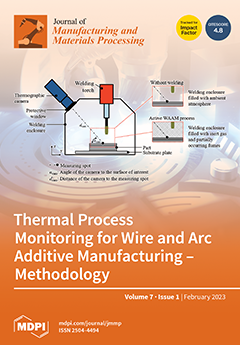A multicomponent white cast iron containing 5 wt.% each of Cr, V, Mo, W, and Co (MWCI) is known to have excellent wear-resistance properties due to the precipitation of some very hard carbides, such as MC, M
2C, and M
7C
[...] Read more.
A multicomponent white cast iron containing 5 wt.% each of Cr, V, Mo, W, and Co (MWCI) is known to have excellent wear-resistance properties due to the precipitation of some very hard carbides, such as MC, M
2C, and M
7C
3. However, it seems possible to improve the wear resistance of MWCI by increasing the carbide volume fraction (CVF). Thus, 27 wt.% Cr based on 3 wt.% each of V, W, Mo, and Co was simultaneously added into the white cast iron. To avoid the tendency of carbides to crack due to high M
7C
3 precipitation levels, titanium (0–2 wt.% Ti) was also added. A rubber wheel abrasive machine test according to the ASTM G65 standard with two different abrasive particle sizes (average: 75 and 300 μm) was used to evaluate the wear characteristics of the alloy. The results show that the wear resistance of these new alloys (0Ti, 1Ti, and 2Ti) is lower than that of MWCI in small silica sand, owing to the lower hardness. However, a different condition is present in large silica sand, for which the abrasive wear resistance of MWCI is lower than that of the 0Ti and 1Ti specimens. In addition, TiC precipitation effectively refined the size of M
7C
3 carbides and reduced their cracking tendency. Thus, the wear resistance of 1Ti is comparable to that of 0Ti, although it has a lower hardness factor. However, the wear resistance of the alloy significantly decreased following the addition of Ti by more than 1 wt.% due to the lower hardness and CVF. Therefore, it can be said that the abrasive wear characteristics of the alloy are not only affected by the hardness, but also by the micro-structural constituents (type, size, and volume fraction of carbides) and silica sand size.
Full article





